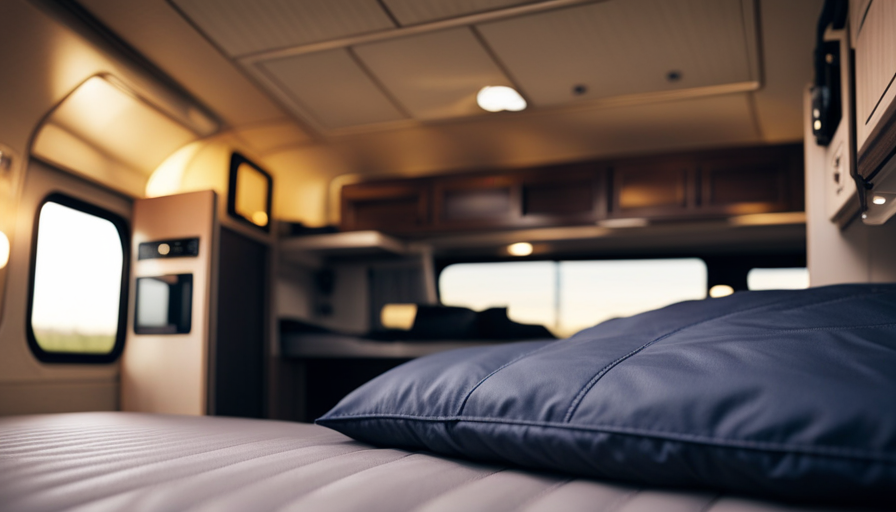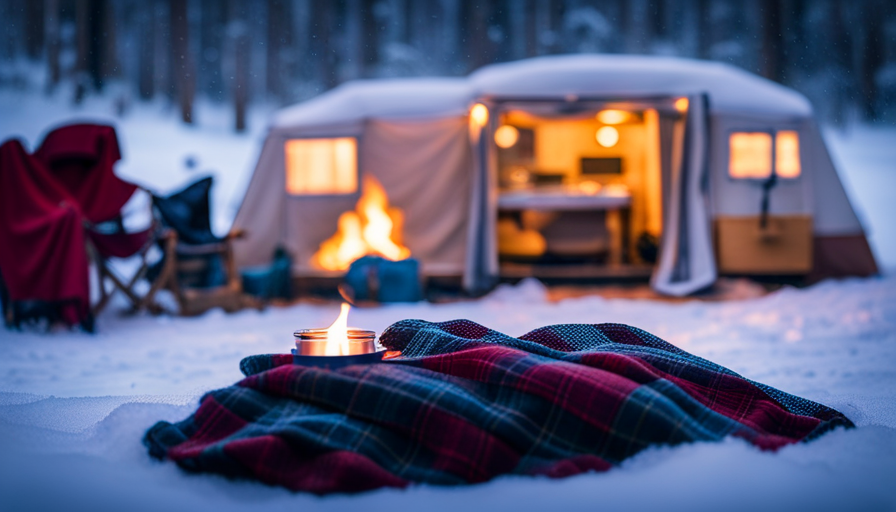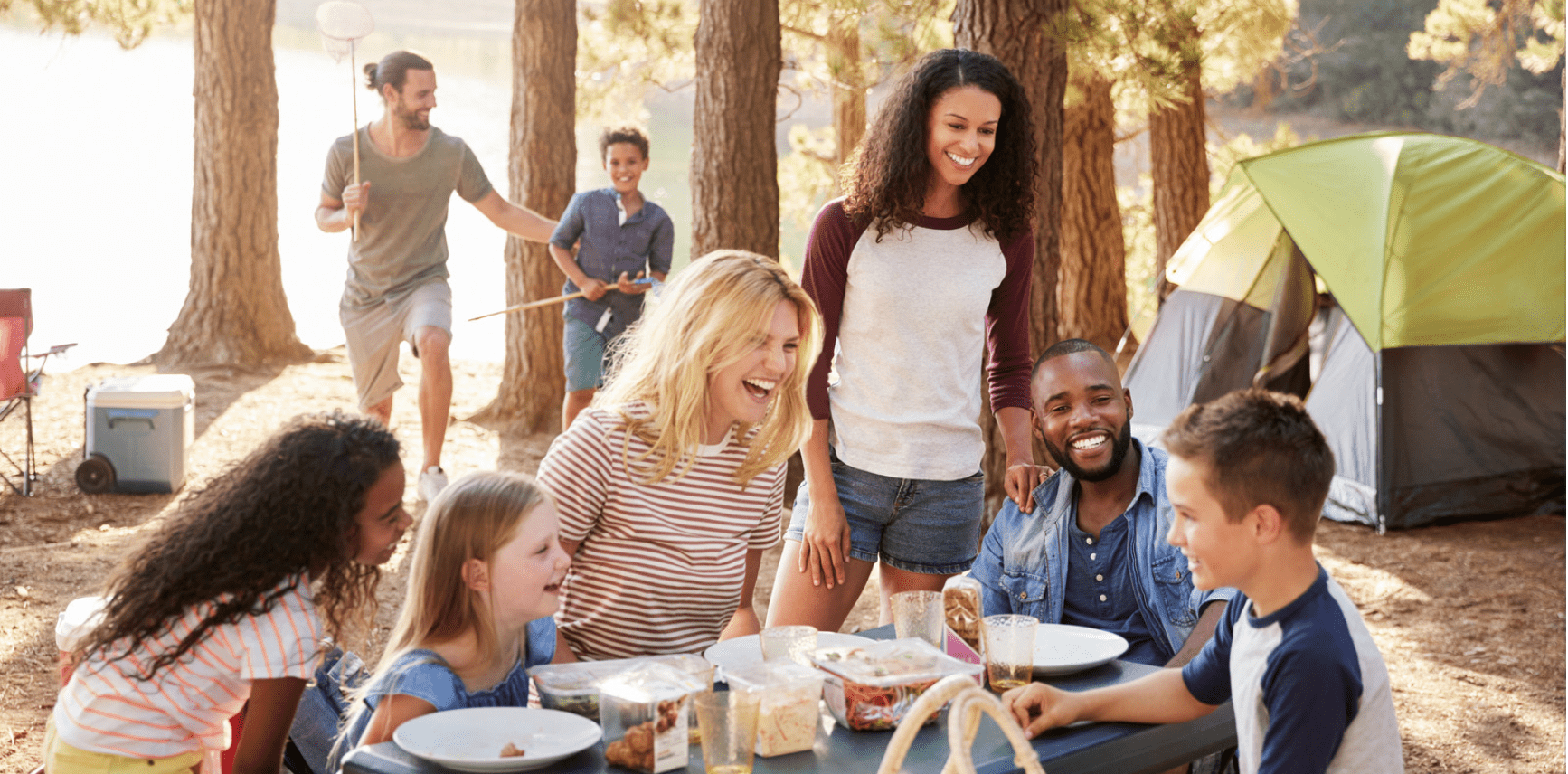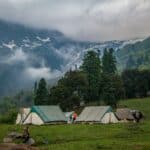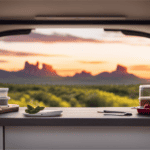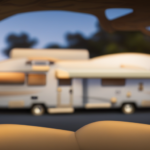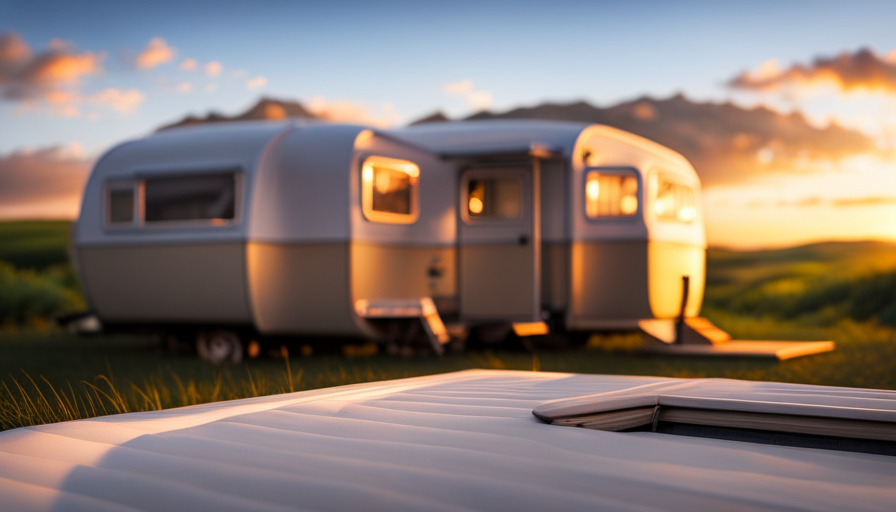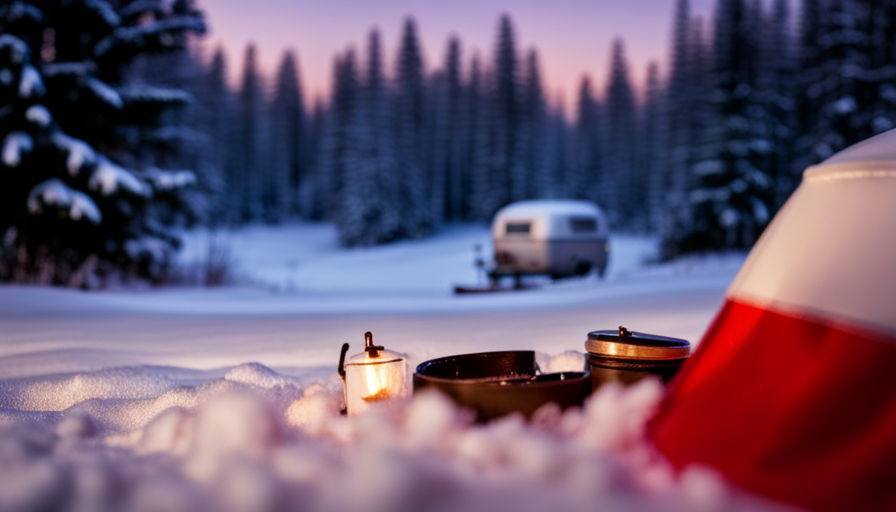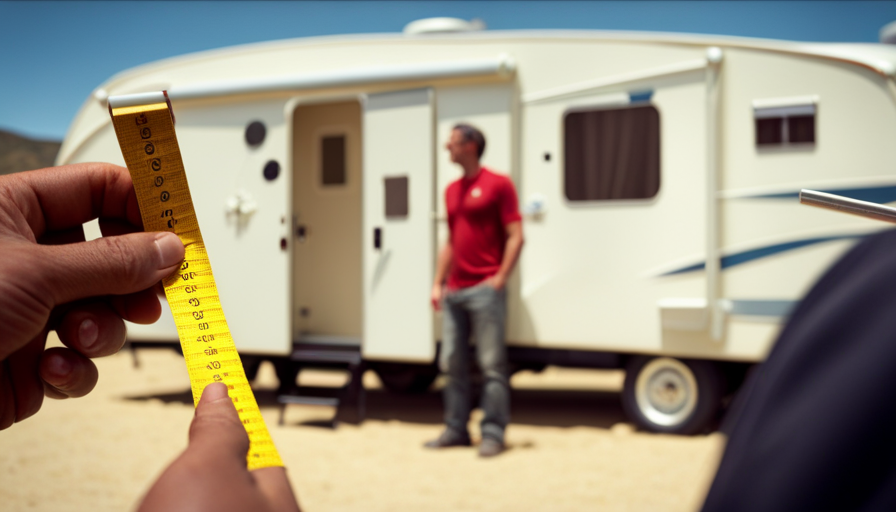You have decided to embark on a thrilling adventure into nature with your camper. The joy of being surrounded by nature, the freedom of the open road, and the thrill of setting up camp in the wilderness.
But wait, before you can fully immerse yourself in the camping experience, there are a few things you’ll need to bring along. And by a few, I mean a lot. Trust me, I speak from experience.
From basic camping gear like tents and sleeping bags to kitchen essentials, food and drinks, personal hygiene items, clothing, and even entertainment and recreation, the list seems never-ending.
But fear not, fellow campers, for I am here to guide you through the ins and outs of what you absolutely need for your camper. So, grab a pen and paper, because we’re about to dive into the world of camping necessities.
Let’s get packing!
Key Takeaways
- Camping gear essentials include tents, sleeping bags, kitchen essentials, food, personal hygiene items, clothing, and entertainment.
- Kitchen essentials for camping include a cooking stove, pots, pans, utensils, plates, bowls, and cutlery.
- Proper food storage for camping requires coolers, ice packs, and non-perishable food options.
- Personal hygiene items for camping include biodegradable soap, toothbrush, toothpaste, portable toilet or shovel, insect repellent, sunscreen, and hand sanitizer.
Basic Camping Gear
Before embarking on your camping trip, it’s crucial to ensure you have all the necessary gear for a comfortable and enjoyable experience in the great outdoors. As seasoned campers, we know the importance of having basic camping gear to make our stay in the wilderness as convenient as possible.
First and foremost, cooking techniques play a vital role in our camping adventures. Whether you prefer cooking over an open fire or using a portable stove, having the right equipment is essential. A sturdy cooking pot, a pan, and a set of utensils are must-haves for preparing delicious meals amidst nature’s beauty. Additionally, don’t forget to pack a cooler to store perishable food items and keep them fresh throughout your trip.
Campfire safety is another aspect that requires attention. Along with the fun and warmth it provides, a campfire can also pose risks if not handled properly. It’s crucial to have fire-starting tools like matches or a lighter, as well as a fire extinguisher for emergencies. Remember to follow campfire safety guidelines, such as keeping a safe distance from flammable objects and always extinguishing the fire completely before leaving the site.
Now that we’ve covered the basics of cooking techniques and campfire safety, let’s move on to the next section about kitchen essentials.
Kitchen Essentials
When it comes to kitchen essentials for camping, there are a few key items that we always make sure to bring along. First and foremost, a reliable cooking stove and fuel are essential for preparing meals on the go.
We also pack a set of pots, pans, and utensils to ensure we have everything we need for cooking up delicious campfire meals.
Finally, we don’t forget to bring plates, bowls, and cutlery, as having proper eating utensils makes the camping experience much more enjoyable.
With these kitchen essentials in tow, we’re always ready to whip up a tasty meal no matter where our camper takes us.
Cooking stove and fuel
For a camper, it’s essential to have a reliable cooking stove and enough fuel to prepare delicious meals on the go. When it comes to cooking techniques, having a stove that can accommodate different methods is key. Look for a stove that allows you to boil, simmer, and grill, giving you versatility in your cooking options.
Additionally, consider alternative fuel options such as propane or butane, as they’re readily available and provide a consistent heat source. It’s also important to have enough fuel on hand for your camping trip, so be sure to calculate how much you’ll need based on the length of your stay and the frequency of your meals.
With a reliable cooking stove and ample fuel, you’ll be well-equipped to whip up tasty meals during your camping adventures.
Now, let’s move on to the next section about pots, pans, and utensils.
Pots, pans, and utensils
Equipped with the right pots, pans, and utensils, your camping meals will be elevated to a whole new level of culinary delight.
When it comes to cooking in a camper, it’s important to have a variety of cooking tools that can handle different cooking techniques. A sturdy cast iron skillet is a must-have for searing meats and creating delicious stir-fries. A small saucepan is perfect for boiling water or making sauces. Don’t forget to pack a griddle for cooking pancakes and bacon in the morning.
As for utensils, a set of tongs, spatula, and a sharp knife will come in handy for meal preparation.
When meal planning, consider dishes that can be easily cooked in one pot, such as one-pot pasta or chili. These dishes are not only convenient but also save on cleanup time.
With the right pots, pans, and utensils, you’ll be able to create mouthwatering meals while enjoying the great outdoors.
Now, let’s move on to the next section about plates, bowls, and cutlery.
Plates, bowls, and cutlery
Plates, bowls, and cutlery are the essential utensils that bring a touch of sophistication to your camping dining experience, serving as the canvas upon which your delicious meals are presented. When it comes to alternative dining options, consider using collapsible or stackable dinnerware. These space-saving options are perfect for campers who want to maximize their storage capacity.
Additionally, eco-friendly dinnerware choices are gaining popularity among outdoor enthusiasts. Look for biodegradable or compostable options made from materials like bamboo or palm leaf. These sustainable alternatives not only reduce waste but also add an eco-conscious element to your camping experience.
As experienced campers, we know that the right plates, bowls, and cutlery can elevate your meals and make them feel more enjoyable. So, when it comes to outfitting your camper, don’t forget to pack these essential items.
In the next section, we will discuss the importance of choosing the right food and drinks for your camping adventure, ensuring that you have a nourishing and satisfying experience in the great outdoors.
Food and Drinks
When planning your camping trip, don’t forget to stock up on all the essential food and drinks. Proper food storage is crucial to ensure that your meals stay fresh throughout your journey. Here are three items that you should consider bringing along for a hassle-free camping experience:
-
Coolers and Ice Packs: A reliable cooler and an ample supply of ice packs are essential for keeping perishable foods like meats, dairy products, and vegetables fresh. Look for a cooler with thick insulation and a strong seal to maintain the cold temperature for longer periods.
-
Non-Perishable Foods: It’s always a good idea to have a stash of non-perishable foods as backup. Items like canned beans, soups, pasta, and granola bars are convenient options that require minimal preparation and can be easily stored in your camper.
-
Meal Planning Supplies: To make meal preparation a breeze, consider bringing along cooking utensils, pots, pans, and a portable stove. Additionally, don’t forget essentials like salt, pepper, oil, and your favorite spices to add flavor to your dishes.
Proper meal planning and having the right food and drinks on hand will ensure that you have delicious and satisfying meals throughout your camping trip. As we move into the next section about personal hygiene items, it’s important to maintain cleanliness and stay fresh while enjoying the great outdoors.
Personal Hygiene Items
Don’t forget to pack your personal hygiene items for a fresh and clean camping experience. When it comes to personal care, it’s important to have the right hygiene products on hand.
One essential item is a good quality biodegradable soap, which can be used for both body and dishes. This will ensure that you can keep yourself clean and maintain proper hygiene while also being environmentally conscious.
Additionally, pack a toothbrush and toothpaste to maintain oral hygiene. A portable camping toilet or a shovel is also crucial for taking care of your bathroom needs in the great outdoors.
Another important item to include in your personal hygiene kit is a good quality insect repellent. This will help protect you from pesky bugs and prevent bites and stings. Additionally, bring along sunscreen to protect your skin from the sun’s harmful rays.
Hand sanitizer is another essential item to have, especially when camping in areas without access to running water.
As we transition into the next section about clothing and footwear, it’s important to remember that personal hygiene extends to what you wear as well. So, let’s make sure we pack appropriate clothing and footwear for our camping adventure.
Clothing and Footwear
Make sure to pack clothing and footwear that are as essential to your camping experience as the refreshing scent of a pine forest on a crisp autumn morning. When it comes to camping, being prepared with the right clothing essentials is crucial.
Start with a good base layer, such as moisture-wicking and quick-drying materials, to keep you comfortable and dry throughout the day. Don’t forget to pack enough socks and underwear for the duration of your trip.
Layering is key, so bring along lightweight, breathable shirts and long-sleeves, as well as a warm fleece or jacket for cooler nights. A waterproof and windproof outer shell will protect you from the elements.
As for footwear options, choose a sturdy pair of hiking boots or trail shoes that provide ankle support and have a good grip. It’s also a good idea to pack a pair of comfortable sandals or flip-flops for lounging around the campsite.
With the right clothing and footwear, you’ll be ready for any adventure that comes your way. Speaking of being prepared, the next item on our camping checklist is a well-stocked first aid kit.
First Aid Kit
When it comes to packing a first aid kit for your camper, there are a few key points to keep in mind.
First, make sure you have a good supply of bandages and dressings to handle any cuts or scrapes that may occur.
It’s also important to include antiseptics and medications to prevent infection and alleviate pain.
Lastly, don’t forget to pack tweezers and scissors for removing splinters or cutting tape and gauze. These items are essential for any camping trip and will ensure you’re prepared for any minor medical emergencies that may arise.
Bandages and dressing
Remember to pack bandages and dressing for your camper so you can be prepared for any cuts or wounds that may occur. When it comes to bandages alternatives, consider adhesive strips or butterfly closures. These are great options for smaller cuts and will help keep the wound clean and protected.
For larger wounds, sterile gauze pads combined with adhesive tape or a self-adherent wrap can provide the necessary coverage.
As for wound care tips, make sure to clean the wound thoroughly with antiseptic wipes or solution before applying the bandage. This will help prevent infections and promote faster healing. Remember to change the dressing regularly and keep an eye out for any signs of infection, such as redness, swelling, or increased pain.
Now, let’s move on to the next section about antiseptics and medications.
Antiseptics and medications
Packing antiseptics and medications ensures a well-stocked first aid kit for treating wounds and preventing infections while camping. Antiseptic sprays are essential for cleansing cuts, scrapes, and burns, helping to kill bacteria and prevent the spread of infection. Look for sprays that contain ingredients like hydrogen peroxide or povidone-iodine for maximum effectiveness.
Additionally, it’s important to include a variety of over the counter medications such as pain relievers, antihistamines, and anti-inflammatory drugs. These can help alleviate symptoms of minor injuries, allergies, and headaches that may arise during your camping trip. Remember to check expiration dates and refill your supply regularly.
Now, moving on to the next section about tweezers and scissors, having the right tools to remove splinters or cut bandages is crucial for proper wound care.
Tweezers and scissors
In our previous discussion, we explored the importance of having antiseptics and medications in your camping first aid kit. Now, let’s move on to another essential component: tweezers and scissors.
These small yet mighty tools can prove to be invaluable during your camping adventures. Tweezers are perfect for removing splinters, ticks, or any other small foreign objects that may find their way into your skin. With a good pair of tweezers, you’ll be able to extract these nuisances quickly and efficiently, preventing any further discomfort or infection.
Scissors, on the other hand, are versatile tools that can be used for various purposes. From cutting bandages and tapes to trimming nails or even preparing meals, a pair of sharp scissors is a must-have in any camper’s arsenal.
To summarize, when it comes to your camping first aid kit, don’t forget to include tweezers and scissors. These tools will undoubtedly come in handy in numerous situations.
Now, let’s move on to the next section where we’ll discuss camping tools and accessories.
Camping Tools and Accessories
Don’t forget to bring your trusty Swiss Army knife, it’s the ultimate tool for any camping adventure.
When it comes to camping tools and accessories, there are a few essentials that should always be on your packing list. First and foremost, a camping hammock is a must-have for relaxation and a good night’s sleep. It’s lightweight, easy to set up, and provides a comfortable alternative to sleeping on the ground.
Another essential is a portable shower, especially if you’re going to be camping for an extended period of time. It’s a great way to stay clean and refreshed, even when you’re far away from any facilities.
In addition to these essentials, there are a few other tools and accessories that can make your camping experience even better. A sturdy camping stove is essential for cooking meals, and a compact set of cookware will make meal prep a breeze. A camping lantern or flashlight is crucial for navigating your campsite at night, and a portable water filter will ensure you always have access to clean drinking water.
As you can see, having the right tools and accessories can greatly enhance your camping experience.
Now that we’ve covered the essentials, let’s move on to the next section about entertainment and recreation. Whether you enjoy hiking, fishing, or just relaxing by the campfire, we’ll discuss everything you need to make the most of your time in the great outdoors.
Entertainment and Recreation
Imagine sitting around a crackling campfire, roasting marshmallows and sharing stories with friends and family, creating memories that will last a lifetime. To enhance your camping experience, here are three essential items that will ensure you have a blast:
-
Outdoor Games: Pack a variety of outdoor games to keep everyone entertained. From classic favorites like frisbee and cornhole to newer games like KanJam or ladder toss, there’s something for everyone. These games provide hours of fun and friendly competition for all ages.
-
Hiking Trails: Exploring nature is a must when camping. Research nearby hiking trails before your trip and choose ones that suit your group’s fitness level and interests. Whether you prefer leisurely strolls or challenging hikes, there are trails out there that will satisfy your craving for adventure and breathtaking views.
-
Entertainment System: Bring along an entertainment system to enjoy movie nights under the stars. A portable projector and screen or a large tablet with a Bluetooth speaker can transform your campsite into a cozy outdoor theater. Just imagine snuggling up with your loved ones, popcorn in hand, and watching your favorite movies or TV shows.
Now that we’ve covered ways to have fun and relax, let’s move on to the next important aspect of camping: safety and security.
Safety and Security
To ensure a worry-free camping experience, it’s crucial to prioritize the safety and security of yourself and your loved ones. When it comes to safety measures, there are a few key items that should be included in your camper.
First and foremost, a fire extinguisher is essential to have on board. This will allow you to quickly and effectively extinguish any potential fires that may arise.
Additionally, a first aid kit is a must-have for any camping trip. It should include bandages, antiseptic ointment, and other basic medical supplies to treat minor injuries.
Emergency preparedness is also vital when camping. A weather radio is a valuable tool to stay informed about any severe weather conditions that may be approaching. It’s also important to have a sturdy flashlight with extra batteries in case of power outages or navigating during the night.
Furthermore, a well-stocked emergency supply kit should include non-perishable food, water, blankets, and essential medications.
Ensuring the safety and security of your camper and its contents is equally important. Investing in a reliable hitch lock and wheel locks can help prevent theft and unauthorized access. Additionally, a carbon monoxide detector is essential to detect any potential leaks from gas-powered appliances.
Prioritizing safety measures and emergency preparedness is crucial for a worry-free camping experience. Up next, we will discuss miscellaneous items that can enhance your camping adventure.
Miscellaneous Items
When it comes to camping, there are a few miscellaneous items that we always make sure to bring along.
First and foremost, trash bags and recycling bins are essential for keeping our campsite clean and organized.
We also never leave home without our portable grill or BBQ equipment, as cooking outdoors is a highlight of our camping trips.
Lastly, camping chairs and a table are a must-have for creating a comfortable and functional outdoor living space.
These items add convenience and make our camping experience even more enjoyable.
Trash bags and recycling bins
Don’t forget to pack some heavy-duty trash bags and a few recycling bins for your camper, because you’re going to generate enough garbage to fill a small mountain! Proper trash disposal is crucial when it comes to eco-friendly camping.
It’s important to leave the campsite just as pristine as you found it. Opt for heavy-duty trash bags that can withstand the rigors of camping and keep the odors contained. Also, investing in a few recycling bins will allow you to separate your recyclables from regular trash, minimizing your environmental impact.
Remember to dispose of the trash and recycling properly at designated receptacles, and never leave it unattended at the campsite.
Now that you have your trash situation covered, let’s move on to the next essential item for your camper: a portable grill or BBQ equipment.
Portable grill or BBQ equipment
Now that we’ve covered the importance of having trash bags and recycling bins in your camper, let’s move on to another essential item: a portable grill or BBQ equipment. When it comes to cooking delicious meals on the road, having a grill is a game changer.
There are two main options to consider: a portable grill or a charcoal grill. A portable grill offers convenience and versatility, allowing you to easily set it up and cook wherever you go. On the other hand, a charcoal grill provides that classic smoky flavor that many outdoor cooking enthusiasts love.
Whichever option you choose, there are a few grilling accessories that are must-haves. Here are four items to add to your camping checklist:
- Grilling utensils (tongs, spatula, brush)
- Grill brush for cleaning
- Grill cover for protection
- Thermometer for temperature control
Now that we’ve covered grilling equipment, let’s move on to the next section about camping chairs and table.
Camping chairs and table
Get ready to relax and enjoy the great outdoors with comfortable camping chairs and a convenient table.
When it comes to camping chair options, there are a few factors to consider. Look for chairs that are lightweight and easy to transport, yet sturdy enough to support your weight. Consider chairs with padded seats and backrests for added comfort. Some chairs even come with built-in cup holders and storage pockets, perfect for holding your drinks and personal items.
As for the camping table, a portable option is ideal. Look for a table that is easy to set up and pack away, with a durable surface that can withstand outdoor conditions. A folding table with adjustable height settings is also a great choice, as it can be used for dining or as a workspace.
With comfortable camping chairs and a convenient table, you’ll have everything you need to make your camping experience even more enjoyable.
Frequently Asked Questions
How do I properly level my camper?
To properly level your camper, start by parking on a level surface. Use a leveling tool or app to measure the slope.
To adjust the camper’s level, use leveling blocks or stabilizing jacks. Place the blocks under the low side tires and drive onto them. Adjust the jacks to achieve a level position.
Common mistakes include not checking the level multiple times and relying solely on visual judgment. Follow these leveling tips to ensure a stable and comfortable camping experience.
What type of power source do I need for my camper?
When it comes to powering your camper, there are a couple of options to consider. One option is a portable generator, which provides a reliable source of power when you’re off the grid. These generators are compact and easy to transport, making them perfect for camping trips.
Another option is solar panels, which harness the power of the sun to charge your camper’s batteries. This environmentally friendly solution is ideal for long-term camping or for those who prefer a renewable energy source.
Can I bring my pet with me on camping trips?
Yes, you can bring your pet with you on camping trips. Many campsites are pet-friendly and allow pets to accompany their owners. Before heading out, it’s important to research and find campsites that specifically cater to pets. These campsites usually have designated pet areas, walking trails, and even pet-friendly amenities.
Additionally, make sure to pack all the necessary items for your pet’s comfort, such as food, water, bedding, and any medications they may need.
Are there any restrictions on campfire usage?
Campfire safety is of utmost importance when camping. Did you know that campfires cause an average of 3,700 wildfires each year in the US? To prevent accidents, there are some restrictions on campfire usage.
Always check with the campground or local authorities for any specific regulations. When it comes to campfire cooking techniques, make sure to use a designated fire pit or ring, keep a bucket of water nearby, and never leave the fire unattended. Safety should always be a priority.
What are some tips for setting up a comfortable sleeping area in my camper?
When it comes to setting up a cozy bed in your camper, there are a few key tips to keep in mind. First, choose the right bedding that suits your comfort preferences and the size of your camper. Opt for high-quality, breathable materials for a good night’s sleep.
Next, consider investing in a comfortable mattress or mattress topper to provide adequate support.
Lastly, don’t forget about proper ventilation and temperature control to ensure a pleasant sleeping environment.
What Equipment Do I Need to Tow My Camper?
When it comes to towing a camper essentials, there are a few key equipment items you will need. Firstly, a heavy-duty towing hitch receiver that matches your vehicle’s towing capacity is crucial. Additionally, a weight distribution system and sway control can help ensure a safer towing experience. Other necessities include safety chains, a brake controller, and towing mirrors for increased visibility. Remember to check your state’s regulations to ensure you have all the required equipment.
What Supplies Do I Need to Winterize My Camper Trailer?
Are you wondering what supplies you need for a winterize camper trailer tutorial? Some essential items include RV antifreeze, a water heater bypass kit, weather stripping, insulation for doors and windows, and a cover for your camper. These supplies will help protect your trailer from the harsh winter weather.
Conclusion
In conclusion, when it comes to camping, we’ve got you covered. We’ve discussed the basic camping gear you’ll need, from tents to sleeping bags.
We’ve also talked about the kitchen essentials, like a portable stove and cooking utensils. Don’t forget to pack plenty of food and drinks to keep you fueled throughout your adventure.
Personal hygiene items are a must, along with appropriate clothing and footwear. And let’s not forget about camping tools and accessories, entertainment and recreation options, and safety and security measures.
Lastly, don’t leave home without those miscellaneous items that always come in handy. So, grab your gear, hit the road, and get ready for an unforgettable camping experience!

